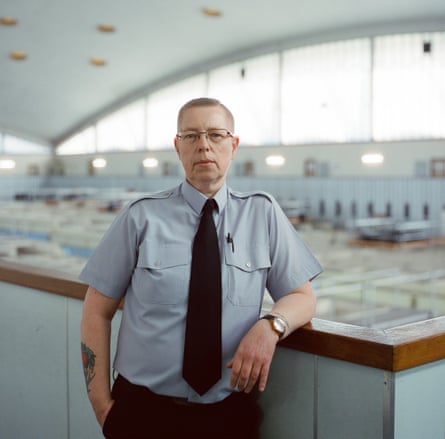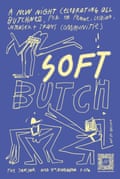I am at a dinner table in south London, in the middle of which sit ceremonially placed items evoking butch culture: a carabiner, a sex harness and an edition of Quim – a lesbian erotic magazine from the late 80s and 90s. It is a Saturday evening in mid-February, and also eating bowls of dal around me are nine regulars from Bristol Butch Bar, set up last spring as a hub for the city’s butch community: among them lesbians, bisexuals, transgender people and non-binary people. I’ve joined them on a “field trip” to the club night Butch, Please! Between us, we have shaved heads, corduroy, jeans, vests, chain necklaces, black trousers, statement shirts and leather.
The butch identity seems to be having a moment. Tonight’s event, as normal, is sold out. “I see about 1,000 people come through a month now – there’s just huge demand for this space,” says Tabs Benjamin, who set up Butch, Please! at the Royal Vauxhall Tavern in 2016. Nights are themed, often with a nod to queer history. This evening there’s a handkerchief code: a discreet way of signalling sexual orientation used by gay men in the 70s who would stuff coloured handkerchiefs in their back pockets.
“There is an absolute resurgence in butch identity, in the sense of belonging and in history as well,” says Joelle Taylor, who in 2021 won the TS Eliot Prize for a poetry collection about butch lesbian subculture. “It’s an exciting time for us,” she adds. “We’re starting to write the histories, memoirs, things that we actually remember.” This year, at least three new books explore butch identity: Hijab Butch Blues by Lamya H; Mrs S by K Patrick; and My Own Worst Enemy by Lily Lindon.
The Bristol butches have an array of handkerchiefs, so I take a navy blue one to signal whether I’m more of a “top” (giver) or a “bottom” (receiver) during sex, depending on if it’s in my left or right pocket. As a butch lesbian who is also “soft butch”, I’d say qualities of my identity include being playful, sensitive and, well, silly. A good example: in the pub, someone deciphers my handkerchief code, only for me to realise I’ve put it in the wrong pocket.
The butch identity is not mainstream, even within the LGBTQ+ community, but things are happening. In March, the Saturday edition of Butch, Please! was started in addition to the existing Thursday night, both once a month. Bristol Butch Bar now gets about 60 people at its monthly meet-ups, where there is an armwrestling league and crafts. “It started off just people we knew, and then it spread to people they knew,” says co-founder Rosie Poebright. Another London club night, Pillow Kings, was set up last autumn, as was Soft Butch in Bristol, both running sold-out events.
In Birmingham, Wile Out, an LGBTQ+ night for people of colour, is popular among studs – an identity embraced by some masculine Black lesbians – alongside events by Urban Slag, On Your Gaydar and, in London, Lick. “I went out expecting a normal night full of drag queens and cheesy pop music, and then I stumbled into the Village, where Wile Out was at that time, and I loved it,” recalls Shan Haywood, a stud. “It’s just nice to have a community of people like myself. I don’t have to walk into the room and be the only Black person there, which is the case in a lot of gay clubs.” Haywood features in a new exhibition in London this month, We/Us, by the butch photographer Roman Manfredi, showcasing portraits and oral histories of working-class butches and studs.
In 2023, the butch identity means different things to different people. For me, a 29-year-old in London, it is the merging of my sexuality with my female masculinity: a physical reflection of how I feel on the inside – that is, inherently masculine – via men’s clothing, short hair and the way I carry myself. It is not that I want to be a man; I love being a woman. But it took me years to say who I am and to look this way. “Butch women and trans women are arguably the people who challenge gender norms in a way that really, really upsets people,” says Benjamin, 37, a self-described “butch dyke”. “When I grew up, in Cumbria, butch lesbians were the ‘worst’ of the lesbians, a word I have found hard enough to say in itself: ugly, disgusting and unlovable. We are, I think, still perceived that way by some today.”

For Prinx Silver, a drag king and transmasculine person in his mid-30s, “butch is that queer identity that allowed me to reclaim my masculinity that I thought I wasn’t allowed to have. I see it more as a way of moving through the world, of being perceived, or like a feeling.” Cassie Agbehenu, a soft butch and Bristol Butch Bar regular, similarly describes it as a “reclamation of masculinity … it can be caring and nurturing and joyful and sexy”. Taylor, a butch lesbian, says: “I’m 55, I come from a feminist movement, and my whole life has been dedicated to trying to persuade people I’m a woman, because they don’t want me to be one. So that’s where the fight is for me.”
What is the butch aesthetic? Again, it depends. “Sometimes,” says Silver, “I’m a butch stereotype,” so he’ll wear boots and flannel or checked shirts. Other times, it’s a vest with jeans, or a leather jacket, like the butches of the 70s. Haywood, 26, describes her “stud starter kit” as an oversized T-shirt and a hat, though she also enjoys wearing a suit and tie. “I feel comfortable in men’s clothes, and I may wear my hair in a certain way, or carry myself in a certain way – it’s a masculine energy, essentially,” she adds. While short hair is liberating for some butches, it’s not a requirement.
As far as history goes, the butch identity has its roots in working-class lesbian communities, as far back as 1940s and 50s America, who reclaimed the word from its use as a slur, with some women dressing to safely “pass” as men with their more feminine partner. In Britain, masculine lesbians included the writer Radclyffe Hall (1880-1943). Despite being marginalised, butches have been on the frontline: some say that it was the butch lesbian Stormé DeLarverie who threw the first punch in the 1969 Stonewall uprising in New York, kickstarting the modern LGBTQ+ rights movement. “We’ve always been here,” as Benjamin says.

By the 80s and 90s, the butch identity had reached its golden era. In the US, the butch lesbian singer kd lang posed for a cover of Vanity Fair with Cindy Crawford; the Calvin Klein model Jenny Shimizu dated Angelina Jolie; and Leslie Feinberg published Stone Butch Blues, named after another subcategory (“stone butch”). In the UK, the underground butch scene was thriving. Taylor describes a “dykedom”: lesbians moving to squat communities in London and other cities, and to the Greenham Common women’s peace camp in Berkshire. The Camden Lesbian Centre and Black Lesbian Group set up in London, as did Gemma, a support group for disabled lesbians, in 1976. “There was a sense that we were all looking out for each other, that we were connected via squats, we were connected by relationships,” says Taylor. This London scene was immortalised by the 2021 film Rebel Dykes, starring Del LaGrace Volcano, whose The Drag King Book documented the 90s drag king scene.
Events, culture and spaces centring the butch identity appear to be having a ripple effect. It was the combination of a group trip to Butch, Please! last February and a screening of Rebel Dykes that helped inspire Bristol Butch Bar. Silver first went to Butch, Please! while still working out his identity, and now performs there. Social media has also created new ways to be together. “The pandemic did have a part to play in those spaces being taken away,” says Benjamin. “A lot of young people in particular were like: ‘Hang on, we need these spaces.’ So it’s created this surge of enthusiasm and support.”
For Poebright, 42, a genderqueer and transmasculine butch, there are also recent, tragic circumstances behind Bristol Butch Bar. Not long after it was set up, a friend in the community died. “The person we lost was a transmasc, non-binary person, and they were in our group when we first set it up,” Poebright says. “There was a bunch of people that met at the funeral, and it turned out we all had a lot in common, including butchness and butch appreciation. So there was a sort of foundation of realising that we can only just barely survive alone, and needing to make spaces to be together in order just to survive the conditions that we’re in.”
These spaces may, to an outsider, just seem like glitter, bondage gear and, in my case, handkerchief mishaps. And, of course, that’s part of it. Drama and infighting are par for the course; bumping into exes in confined spaces is only to be expected. But for lots of people, whose lives have been reduced to nothing more than a joke or a sexual fetish, these club nights are life-changing. As Haywood puts it: “It’s just what everybody wants, really, isn’t it? To have something they identify with when they’re out.”

